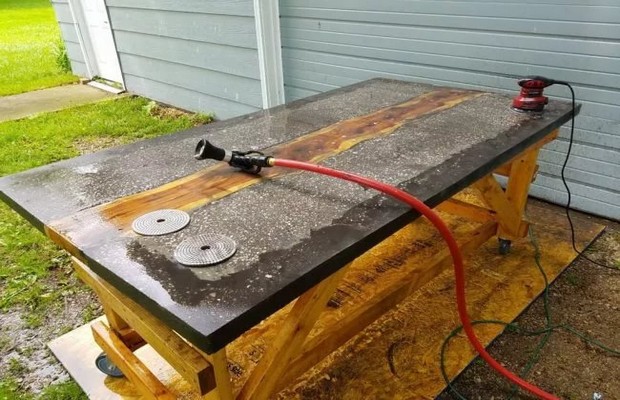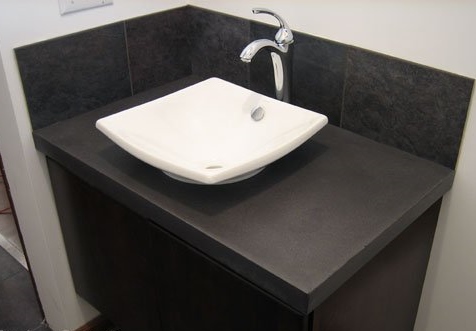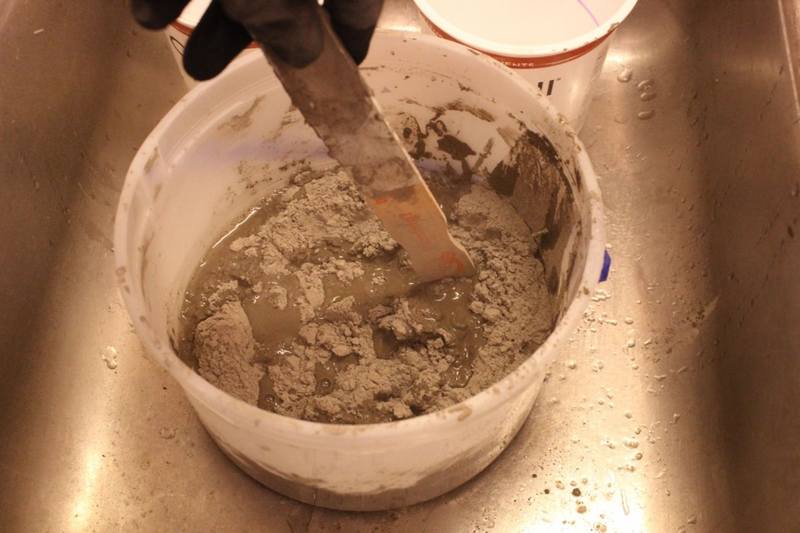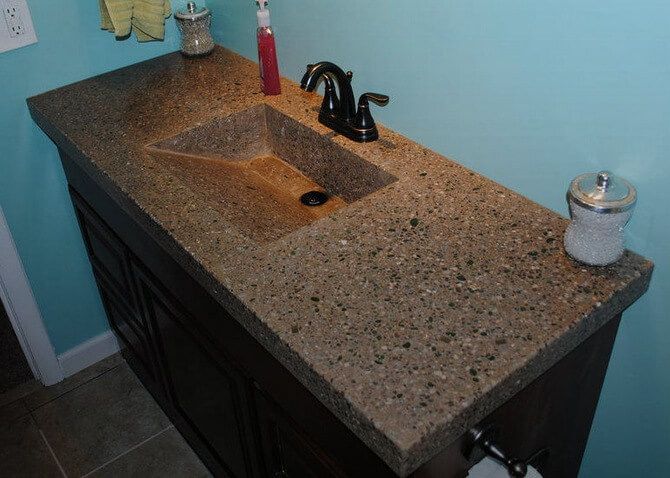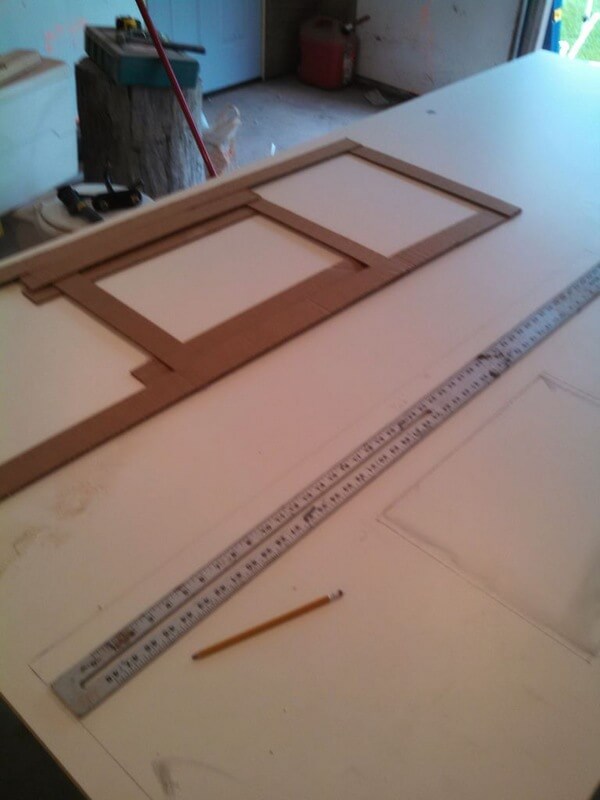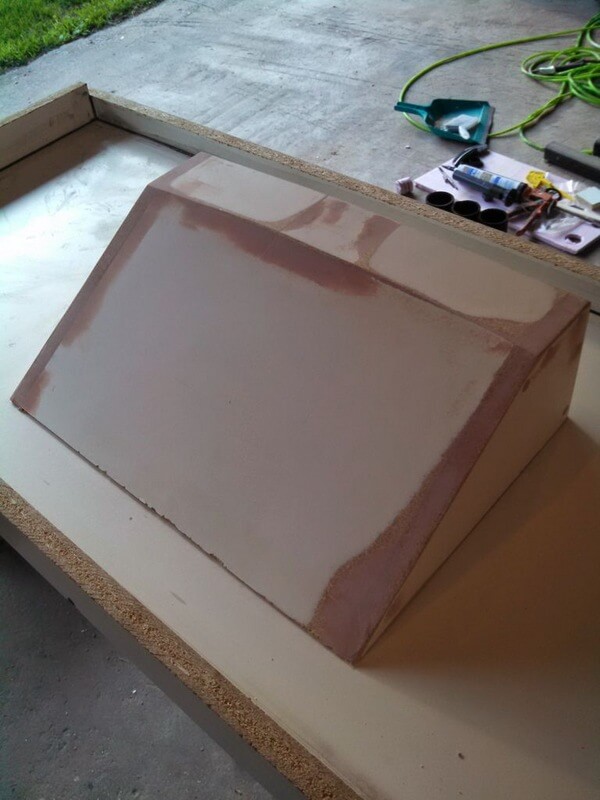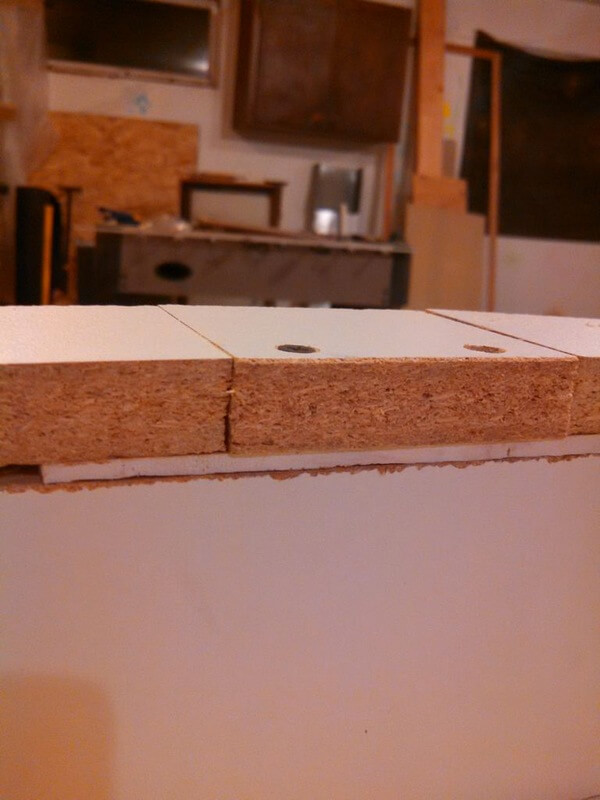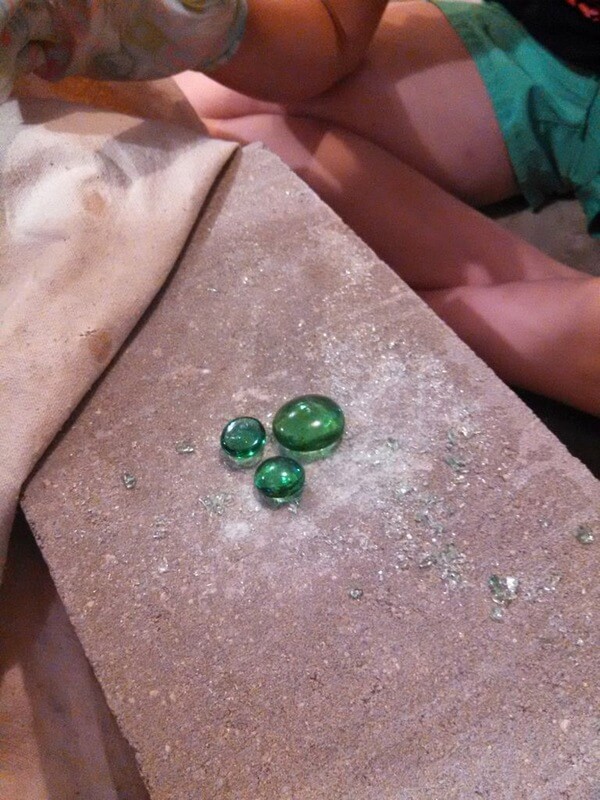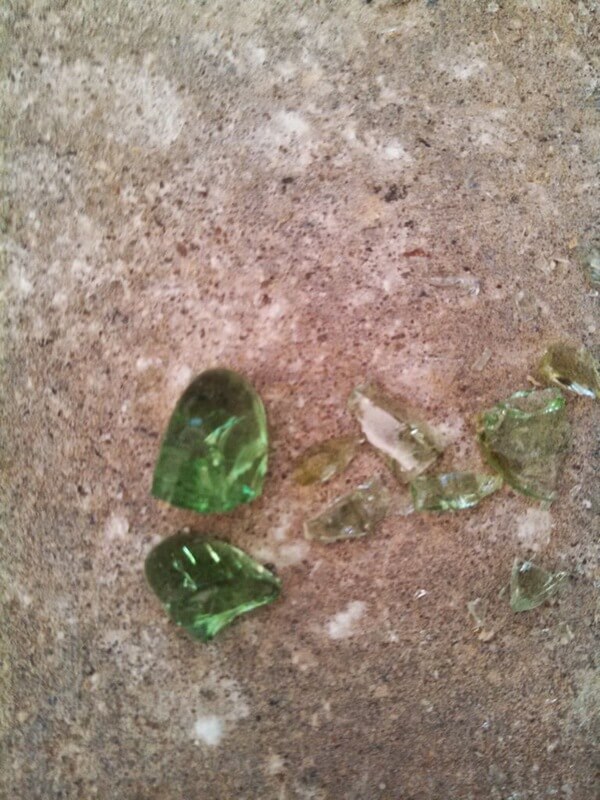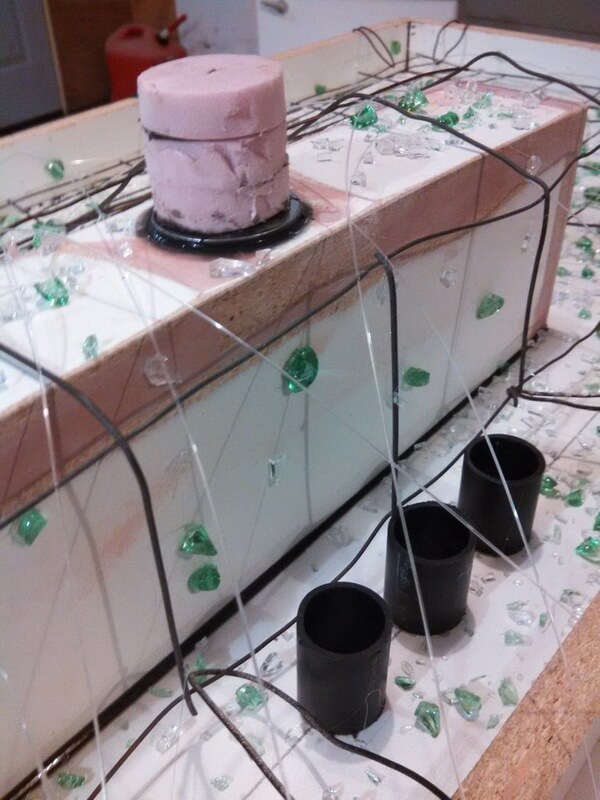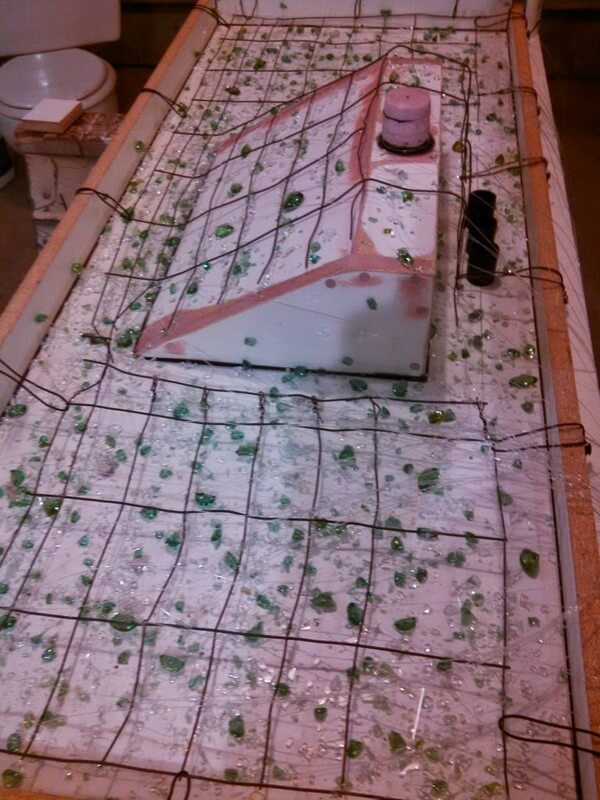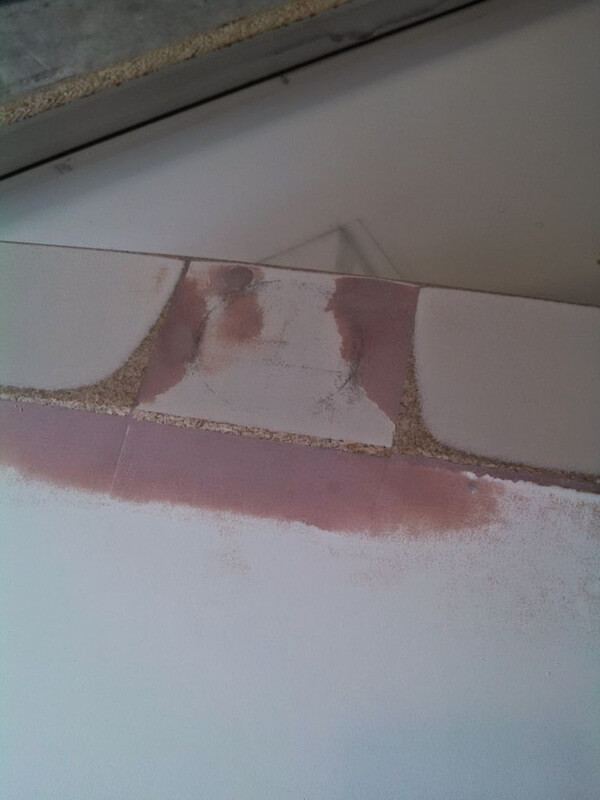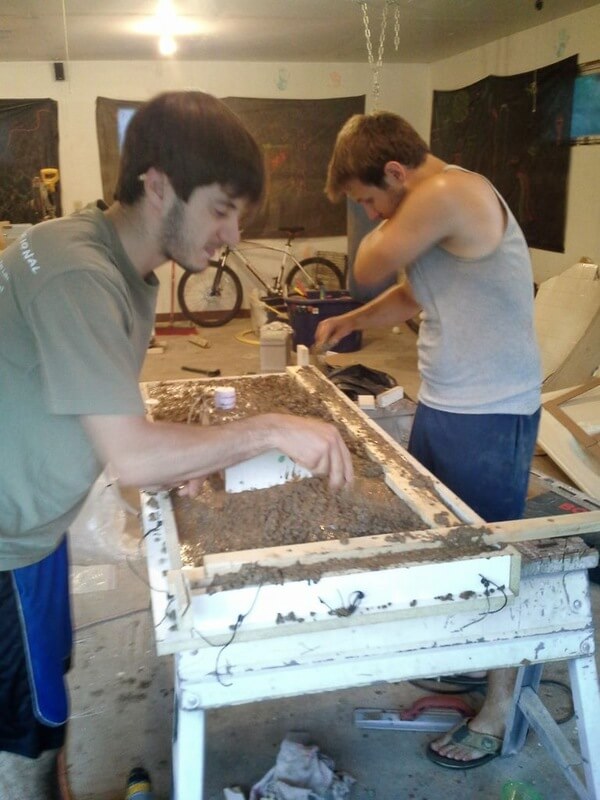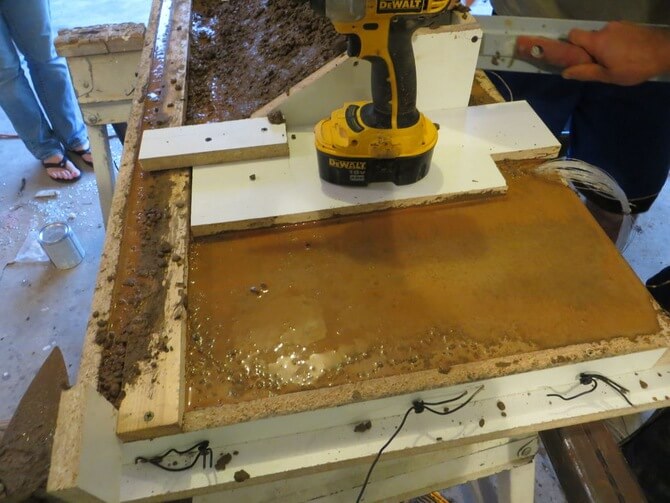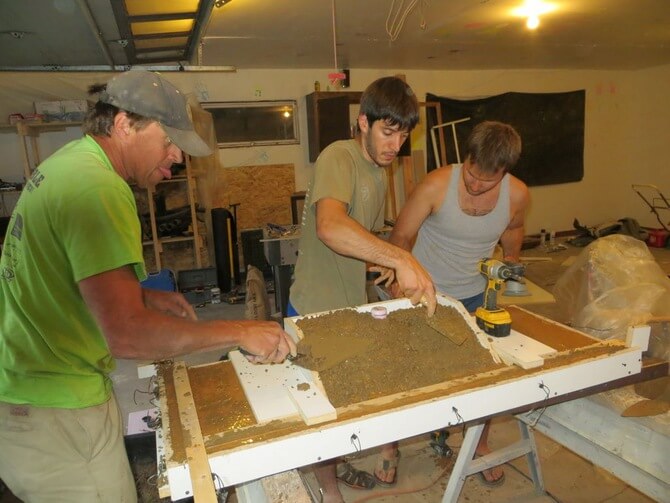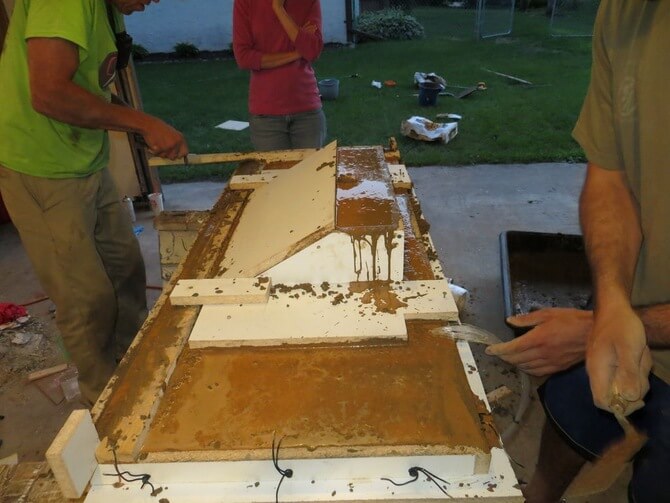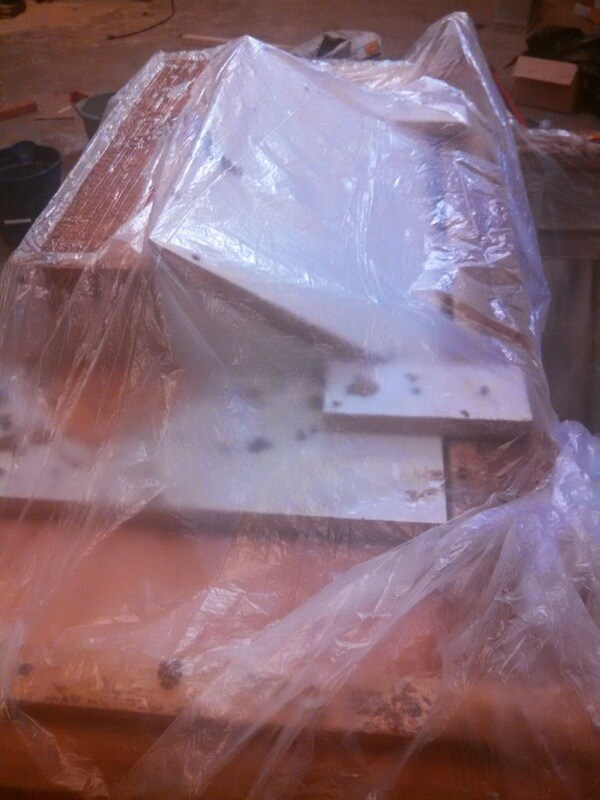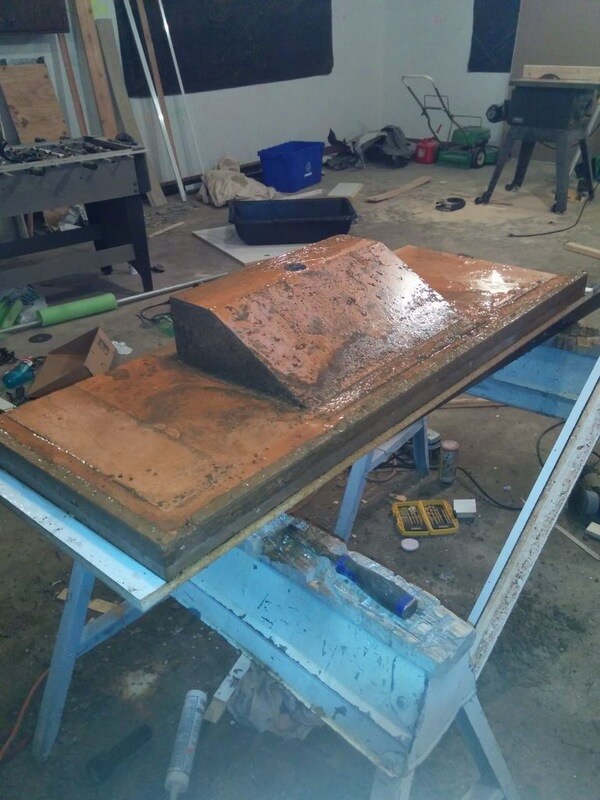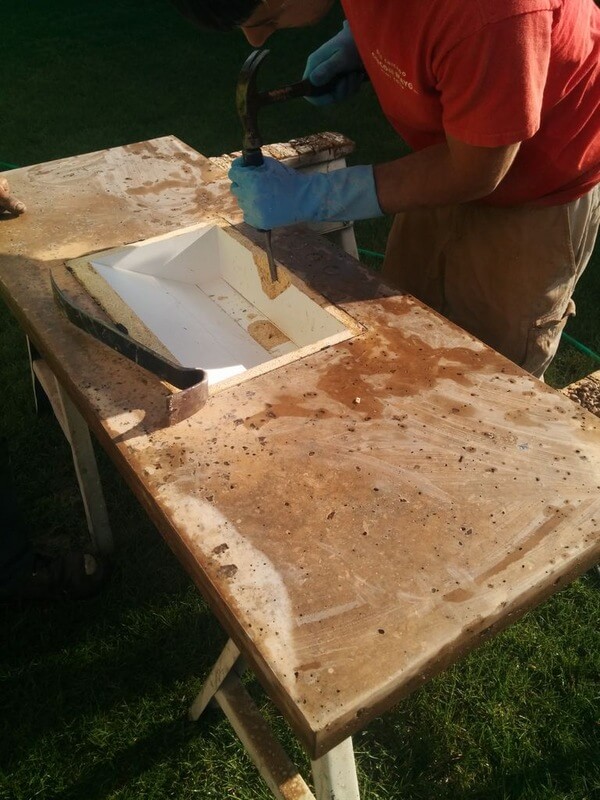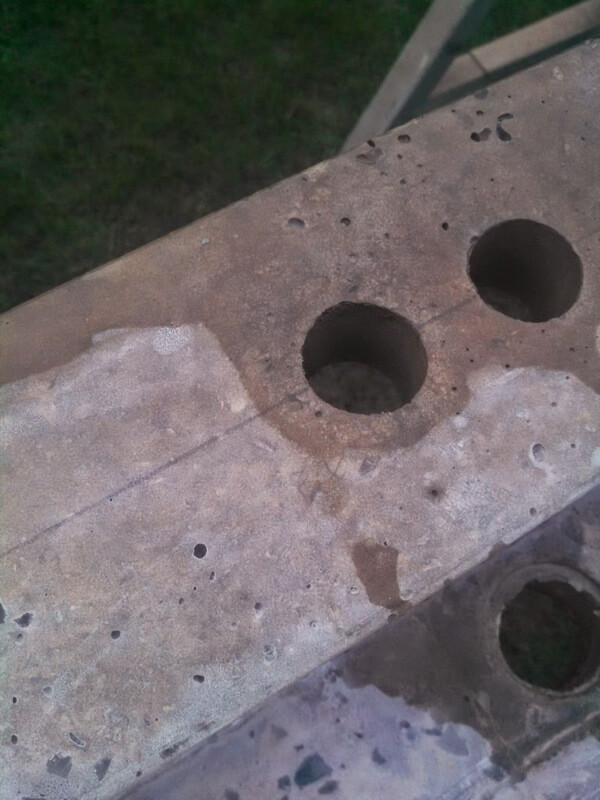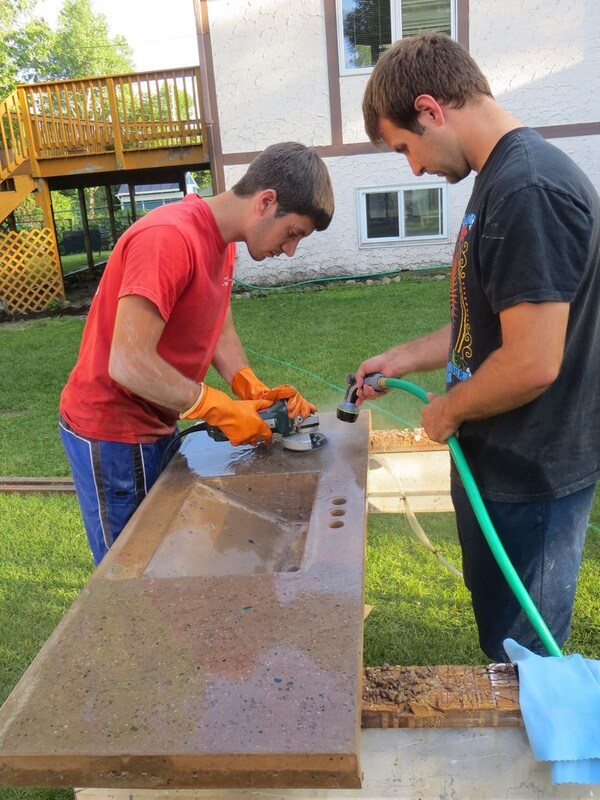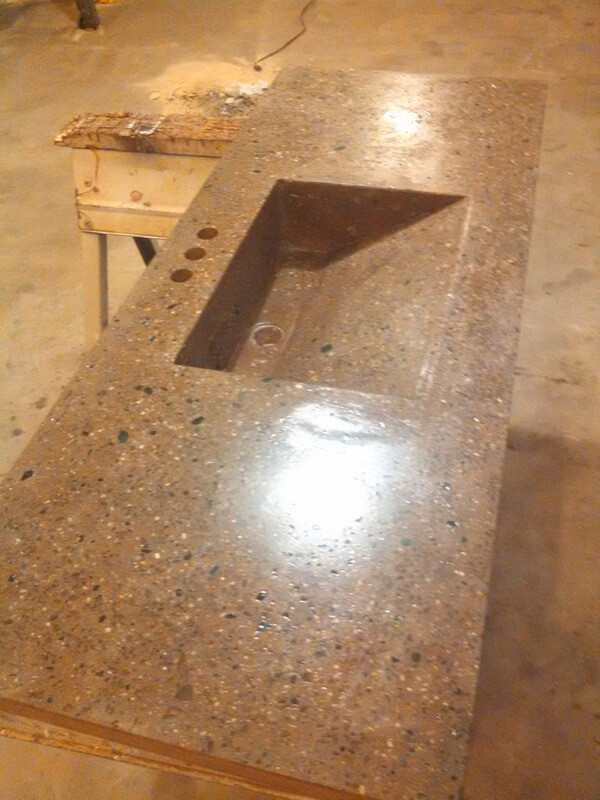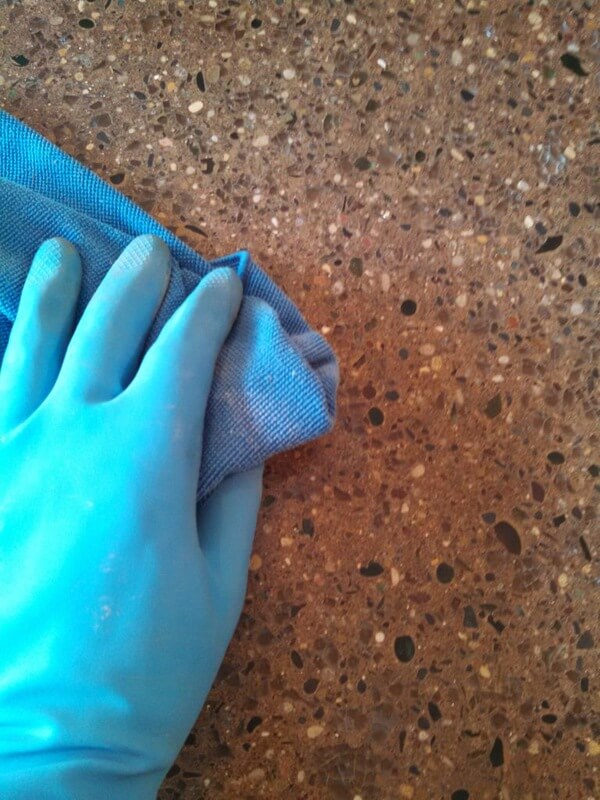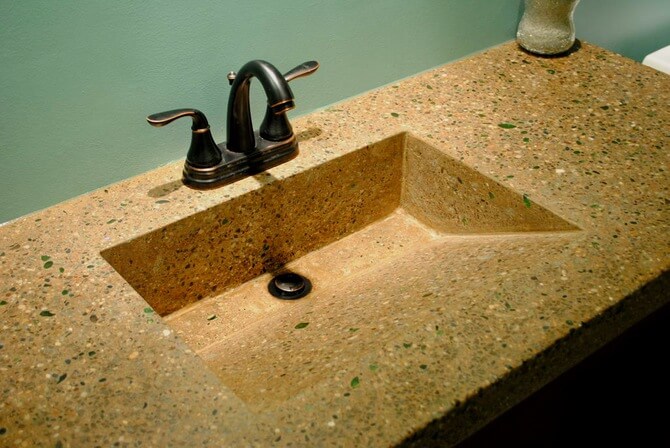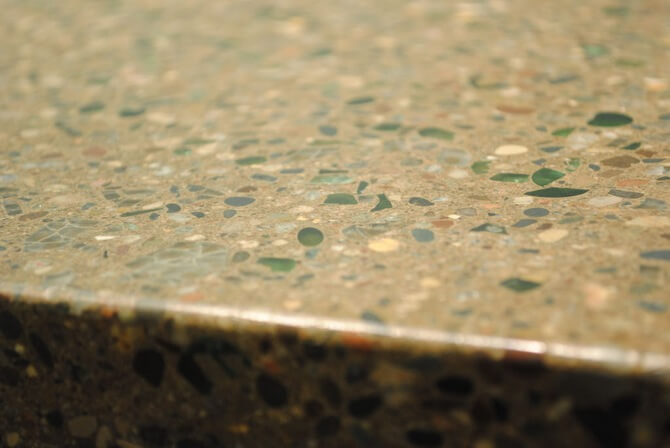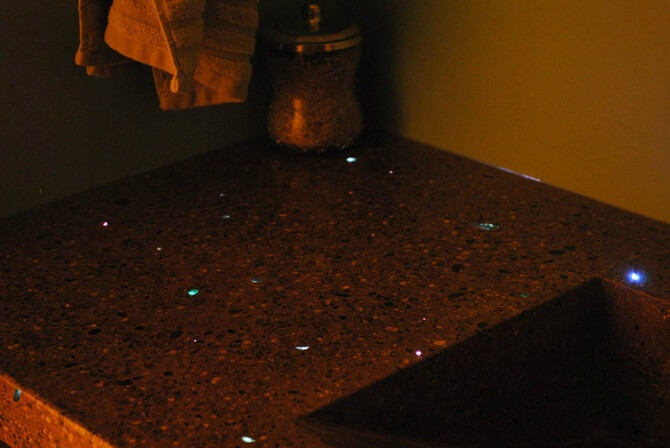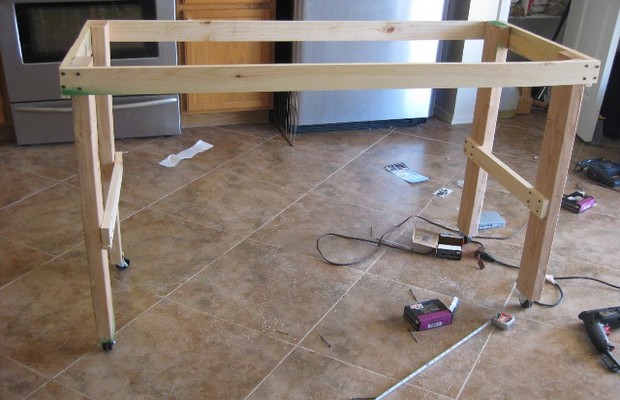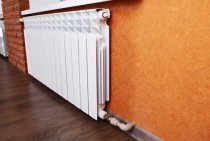Design Options
Concrete shell structures can be classified according to a fairly large number of features.
Depending on the design, there may be:
- Concrete countertop with sink cutout
- Free standing sink.
Each of the options has its own advantages and disadvantages. The choice depends on the room where the sink is supposed to be installed. For the kitchen, an excellent option would be to install a combined sink. So, at no extra cost, you can also mount additional work surfaces, which are always a weak point of the interior, since a large number of surfaces are ugly, and a small number is inconvenient.
In order for the same option to be appropriate in the bathroom, you need to have a room of sufficiently large dimensions. Rarely in a modern apartment a bath of this size is provided. But in a private house in a spacious bathroom, this will be a good option. Such a sink will emphasize the spaciousness of the room. If this is not particularly necessary, then in the bathroom it is better to do with a separate product.
Depending on the shape, the sink can be:
- geometric shapes
- Traditional or round shapes
- original

It all depends solely on the preferences of the owner. The only thing worth mentioning is the depth of the sink. If you install a purchased product, then be prepared for a shallow sink depth. It's not just done. The fact is that only with such parameters, concrete fully reveals its aesthetic properties. A deep concrete sink is not beautiful. Therefore, if due to technical requirements you require a deep wash, it is better to choose another material.
Benefits of concrete
So, let's consider what are the main advantages of this material and what sinks can be made from it.
The first is the low cost. This building material is available to almost everyone.
The second is high strength and reliability. Concrete consists of components such as cement, sand, gravel, and special additives (for example, marble or quartz chips). All these components give the material stability and durability.
The third quality is versatility. Concrete sinks fit equally well into any design style. This is especially true for loft, hi-tech, minimalism, grunge styles.
Design
Regardless of the end result of the manufacturing process, you first need to create a project. The completed drawing will facilitate the presentation of the entire production process, help to foresee and eliminate possible errors and difficulties. Generally speaking, the drawing will greatly facilitate the implementation of all work.
Initially, you should find out what components your kitchen set consists of. To do this, you need to study the existing list of similar products and opt for the required option. After that, you need to find out the exact dimensions of the upcoming countertop for concrete. To find out, you need to measure the length with the width of the empty area, taking into account the pieces of furniture that are nearby. In the event that the product will be in contact with the corner, you need to measure the corner, since in reality it may not be straight.
For normal and full functioning, the thickness of the concrete countertop should not be less than 5 centimeters. But it’s not worth doing much thicker either, because in this case the mass of the product increases significantly.
Of great importance is the location of the sink in the kitchen, its size and shape. It would be much better to purchase a sink before starting to manufacture the product.
In this case, it will be easier to make a hole, and the result will be more accurate. An equally important detail is the location of the tap, because it will also need a hole.
In the case of a built-in sink, you need to check if it overlaps the countertop. If everything is in order, then you can start making a template for the hole. To do this, turn the sink over and circle it with a construction pencil.
In the case of an overlay sink, it is necessary to measure the inner part where it will come into contact with the overlay part. If the inner part does not have a rectangular shape, then it is worth making a rectangular template according to the largest measurements of the inner part. The main thing is to make such a hole so that the sink fits without fail. It is even possible for the hole to be slightly larger than required.
Now you can draw a real-size drawing using the received data. To do this, you need a sheet of plastic or chipboard. On it we carry out design
We apply all the necessary dimensions and holes very carefully and carefully, everything should be as close as possible to the intended product
We draw a drawing and select materials preparation in full swing
One of the most important stages on the way to the manufacture of a concrete surface is the creation of a drawing. This is necessary in order to accurately know the dimensions of the countertop, as well as its appearance. In order for the product to be firmly attached and not to stagger during operation, it must be installed as tightly as possible to the walls. You should also not forget about the sink - its dimensions and location are indicated in the drawing. The same applies to the corner, because kitchens are very often corner, and that's where it usually happens. Ideally, the angle is straight and is 90 degrees - this will greatly facilitate the work process. If the angle is slightly different, it will be necessary to take this into account during construction work, and also note it when making a drawing.
In some cases, it is recommended to make a surface from several separate components. This method is due to the fact that for large kitchens the surfaces are very bulky and heavy. If the product is divided into several smaller structures, then it will be much easier to work and install them. In addition, it will be possible to avoid cracks and chips that may appear in case of unsuccessful processing or moving heavy objects. Having drawn a sketch, you can begin to collect the necessary materials and tools. Choose high-quality and reliable equipment. For work you will need the following items:
- plastic sheets 18 mm thick;
- plywood sheets;
- hardwood boards;
- sand and cement for mixing the mortar;
- polymer concrete made from acrylic resins;
- reinforcing mesh to strengthen the structure;
- decorative elements - shells, small pebbles, broken glass to decorate the surface;
- glue spray;
- silicone sealants;
- colors - special coloring pigments to give the surface the desired color shade.
Naturally, we cannot do anything without tools. For successful work, you will need tools such as:
- 1.
building level; - 2.
wood saw; - 3.
screwdriver - required for mounting the formwork and its subsequent disassembly; - 4.
spatulas, levelers, trowels for working with uncured concrete; - 5.
polishing wheels; - 6.
sandpaper; - 7.
Sander.
Formwork preparation
When making your countertop, it is important to perform this area of work as accurately and accurately as possible. After all, the strength of the product and its appearance in general will depend on the quality of the workpiece.
After a decision has been made regarding the height of the structure, it is necessary to cut off the details of the required length from the beams - these are the vertical parts of the future formwork. They will need to be fixed to the floor. To do this, you need a profile. If the contact with the walls is direct, then the racks must be drilled through. They are fixed with anchor dowels. After fixing, the vertical parts are connected to the horizontal ones.Thus, the formwork frame is ready.
To make the lower part you will need a wooden sheet of MDF. The formwork must be made in such a way that the concrete can later be pulled out without damaging it.
If a sink is provided in the countertop, then inside in the required place you need to lay out a metal ring. Also, with the further use of the hob, it is also necessary to designate this place.
Bathrooms are a special place in the house, a kind of island of bliss, created for relaxation and relaxation. To be alone with yourself and soak in a fragrant bath after a hard day's work is a great pleasure.
Despite the often compact size of this room, it is important to create a cozy and comfortable interior in which an atmosphere of peace and harmony will reign. The arrangement of the bathroom should be taken seriously, carefully considering every detail.
Incorrectly selected furniture and accessories can spoil the whole look and impression of the interior at once. And, on the contrary, a small touch, and the interior will change and sparkle with new colors.
The arrangement of the bathroom should be taken seriously, carefully considering every detail. Incorrectly selected furniture and accessories can spoil the whole look and impression of the interior at once. And, on the contrary, a small touch, and the interior will change and sparkle with new colors.
Stages of work
Regardless of the product being made, first you need to find out its size and shape. If you have to replace the old countertop, then you can use its measurements
If a completely new product is being manufactured, then it is worth taking measurements of the base, as well as taking into account the existing requirements for the selected room
In order to have a template in front of your eyes, you can try to make a drawing of the countertop on paper, it is even allowed not to make marks for different types of holes. Next, you will need a full-fledged life-size template. To do this, you need to take a sheet of thick cardboard, of such a size that a full-fledged template eventually comes out. If the cardboard is small, then for the actual volume of the product, you will have to glue the parts. If there is a large cardboard, then it is enough just to cut out the necessary layout. When the template is ready, you need to check that it fully matches the dimensions. To check, it is worth attaching it to the desired area and making sure that everything is accurate and there are no distortions. After such checks, the concrete countertop will turn out quickly and easily. Now you need to divide the template into separate parts. Once you have ready-made detailed templates on hand, you can begin the production of the product itself.
Style and design
The style of the shells varies depending on the shape of the bowl and its frame. In the kitchen, as a rule, the bowl is installed on a surface made of rough, varnished wood. This combination of incongruous gives a special effect, which in design is called eclecticism.
The shape of the bowl is usually a flat stone with a small notch in the middle. Separately stand bowls in the form of a hemisphere
They're nice looking and bulky enough to draw attention, but they're more of a piece of furniture than a handy device. Therefore, it is better to refrain from such a purchase.
Bowls recessed into the countertop are distinguished by special convenience and functionality. It is easy to move dirty dishes from the countertop into such a sink without spilling anything on the floor. Everything else depends on the customer.
The process of creating a sink from concrete
So, we prepared the tools, learned about the pros and cons, got inspired by the forms, it's time to get to work!
Marking is applied to the prepared (cleaned from paint or plaster) wall surface, near which the sink will be located. In order to avoid distortions, a building level is used.Since you will create your masterpiece from scratch, there are no restrictions, you start only from your own taste.
Now it's time to get down to formwork. First, make a cardboard layout: firstly, this way you will clearly see the result that you need, and secondly, if the expectation does not match reality, it is faster and easier to redo the cardboard layout than the finished formwork.
After that, you can begin to implement it. The base and sides are made separately, then they are fastened together with self-tapping screws and steel corners. Joints are treated with sealant.
Now we create something with which the sink will be firmly attached to the wall - reinforcement. We punch holes in the wall for bars with a puncher and a drill. We put a metal washer on each of them, weld it and hammer it in so that the reinforcement is held tightly in the wall. The intersections of the bars are also welded or connected with wire.
We install formwork on the resulting structure. Additionally, we attach it to the wall with corners, dowels and screws. But that's not all: since the next stage is already connected with concrete, we immediately place brick supports from below, which will take on all its mass.
Time to take the solution! We mix cement, sand and crushed stone in a ratio of 1:3:3. Then add as much water as this mixture turned out (that is, if half of the bucket is filled, then you need to add enough water to fill the bucket completely).
We mix our "porridge-malash" with a construction mixer. After that, pour it into the formwork in layers. If you want to create a decorative colored surface, then a separate solution is prepared for concrete with a dye.
Now it remains to wait. After a week, you can remove the formwork and plastic pipes. Dismantling is done from top to bottom. It is best not to remove the supports at this stage, even if the sink looks solid.
You can start decorating. Here it is already up to your taste: you can lay the tiles, or simply sand the surface and apply a moisture-resistant coating on it.
After a month, the concrete will finally harden and you just have to remove the supports and connect the plumbing equipment. Everything is ready! Happy hand and dish washing!
What you need to make a concrete sink with your own hands
Sand concrete M300, M400 or M500 is best suited for this purpose - it is these types that can provide the smoothest possible surface. It will be even better if you add a plasticizer to the solution. Not everyone likes the gray color of concrete, so if you are one of them, you can additionally purchase a special dye at the hardware store.
You will also need clean fine-grained sand (from 1.2 to 2 mm). Just be sure to wash and dry it before use.
Don't forget the formwork. It will require chipboard, boards or plastic sheets. If you want to experiment with shape, thin sheets of zinc-coated steel are ideal for this, as they are strong and yet bend well. In addition, you will need sheets of cardboard to create the layout.
To reinforce concrete, steel bars with a diameter of 10–15 mm will be needed, and to strengthen the joints, corners and tapes from the same material, fasteners and sealant will be needed. To support the weight of the sink while it dries, you need strong supports - I recommend bricks as the easiest, most durable and inexpensive means. The sink should be wrapped in plastic wrap while it dries, so make sure you get that too.
If you want to make an exterior finish, for example, with tiles, you will additionally need tile adhesive and grout.
And finally, the list of necessary tools:
- jigsaw;
- perforator with drills for concrete;
- screwdriver or screwdriver;
- hammer;
- metal scissors;
- welding machine;
- a large bucket to mix the concrete solution in it;
- construction mixer;
- ruler or tape measure, pencil;
- building level.
Versions
There are no restrictions on the shape - rectangular, square, round, with curves ... Order a washbasin with or without a countertop, with one sink or with another required quantity. The base for the countertop is made of any material that you can independently find elsewhere or purchase from us.
Advantages of the countertop sink from the Bershovo workshop:
- Stylish design that will harmoniously complement the interior of the room.
- The monolithic design guarantees protection against leaks.
- There is an additional place to place the necessary items.
- if you want to visually expand the space - choose narrow and long models,
- to fill spacious rooms, massive options are used (thick and wide countertops with 2-3 sinks).
You can buy a table for a bathroom with a tabletop by calling the number listed in the "contacts" section. Company consultants will answer your questions.
The loft is now more fashionable than ever. And that's why everyone wants to replace even the usual faience sink with something more “loft-like”. There are eccentric solutions, for example, a copper basin with a hole in the middle or a galvanized bucket in general, but such ideas are difficult to combine with a modern interior, and are not very convenient to use in everyday life. If you don’t want to complicate your life, then a real concrete sink will be the highlight of your loft and cannot be compared with any other option, in all respects.
Concrete is still not faience, but we are here to find out all the pros and cons
This is at least original.
This is an exclusive - each of our sinks is made by hand and can be considered a work of modern art.
It is durable - a well-made concrete sink will last for centuries, and maybe even thousands of years))
It is reliable - breaking off a corner is not as easy as breaking off a faience sink
This is unique - the picturesque texture of concrete cannot be imitated by any other material.
Now for the cons:
Vulnerability. A concrete washbasin can either be varnished or impregnated. In the first case, it is well protected from dirt, but it is easier to scratch the coating than earthenware enamel. In the second case, it is difficult to scratch, but it is necessary to constantly (every 2-3 months) renew the impregnation, and if this is not done, then sooner or later spots may appear, which only grinding will help get rid of.
Price. It is very difficult to set up the production process of shells on the conveyor. And therefore, if we are not talking about a piece of foundation weighing 200 kg, but about a sink made of high-strength and picturesque concrete, weighing an acceptable 20-40 kg, then this is painstaking manual labor with a large number of stages, complex technology and expensive materials.
Since all over the world, concrete sinks are much more often protected with varnish, we will tell you more about it. Varnish for concrete in the interior meets several requirements:
1) it must be non-toxic;
2) lay down a beautiful matte thin layer so that it is difficult to identify it as something foreign;
3) do not allow water to pass through, because if the varnish passes water, then it will pass pollution along with it
4) be as scratch resistant as possible
As much as possible, only one type of varnish meets all these requirements - polyurethane, and even then not any. We did a lot of experiments to choose the best varnish, but, unfortunately, we did not find the perfect one in all respects. So when purchasing a concrete sink, get ready for careful handling.
Do not expect wonderful performance and practicality from concrete, or you will be disappointed. Although if you take care of such a product properly, then there will be no problems with it. Do not use aggressive acidic or strongly alkaline cleaners or abrasive sponges.
P.S.: And for lovers of everything real, I will recommend bare concrete without coating. In this design, the sink will be as natural as possible. And over time, becoming covered with a patina during operation, it will only get better.
Pros and cons
Concrete as a material for a sink has a sufficiently large number of advantages:
- Low corrosion activity and resistance to moisture. Concrete coated with a special composition will retain its appearance and shape for decades.
- Low material cost. Concrete is not a natural stone, so the cost of making or purchasing a concrete sink on your own is quite comparable to buying an ordinary ceramic sink.
- High aesthetic qualities. With the help of various kinds of coloring additives, you can change the color of the sink within a fairly wide range. At the same time, the shape of the future shell is given by a mold for casting, which can be absolutely any. And special inclusions, which are created by replacing crushed stone with another filler, can create a full-fledged imitation of marble.
The cons of a concrete sink, like any building solution, also have:
- Bulky. Whatever shape the future sink has, in any case it will look cumbersome. This technique is not suitable for sublimely high interiors. Here, the design of a bathroom or kitchen in the style of a medieval castle or rustic style will go well with this choice. In addition, it must be borne in mind that bulkiness visually reduces the height of the room. Therefore, for low rooms it is better to choose a different design.
- Weight. No matter how much you call concrete an imitation of stone, they weigh, if not the same, then very similar. Therefore, fastening to reinforcement is required, which passes through the entire wall. For fastening, it is better to choose a load-bearing wall. An option for those who do not want to drill a load-bearing wall would be to install a separate shelf under the sink. Such a shelf can easily withstand the weight of the product and does not require special skills in installation.
Necessary materials and tools
The whole difficulty of pouring a sink with your own hands lies in the fact that under it, as well as under any concrete product or structure, it is necessary to make a formwork. The formwork must be reliable and waterproof. Therefore, boards, OSB boards, moisture-resistant chipboard panels are used as materials, the thickness of which should not be less than 20 millimeters.
To create the shape of the shell, or rather, its bowl, you will need a metal sheet with a thickness of no more than 1 millimeter. Usually galvanized sheet is used for this. To create a reinforcing frame, you will need bars of metal reinforcement with a diameter of 10 millimeters. Be sure to purchase furniture corners, with the help of which the parts of the formwork are connected.
From the tools you will need:
- perforator with drills with a diameter of 10 millimeters;
- scissors for metal, with which a shape will be cut out under the bowl of the sink;
- screwdriver for fastening the formwork;
- hammer;
- saw or jigsaw;
- mixer for mixing concrete mortar;
- container for mixing concrete;
- building level;
- roulette;
- pencil;
- notched trowel;
- plastic pipes for the formation of a sewer drain (40 mm in diameter) and a mixer landing site (32 mm in diameter).
For the manufacture of plumbing fixtures, it is recommended to use concrete grade M400 or M500. The classic recipe for M400 concrete is cement in one volume, sand and crushed stone in two volumes (1: 2: 2). Since a concrete mortar is used for the sink using artificial stone technology, instead of crushed stone, granite or marble chips should be added to the mixture, or rather screenings, which are three to four times cheaper.
Unique products from the Bershovo workshop
Take, for example, decorative concrete bath countertops, they look very stylish and sophisticated. They are able to become the "highlight" of any bathroom.In addition, this material is excellent for use in wet areas. A decorative concrete bathroom sink and countertop will serve you for many years without any complaints.
You will find a large assortment of decorative concrete bath countertops at our Bershovo workshop.
Such products are created from decorative concrete, which is characterized by high performance: it is resistant to temperature extremes, humidity and the formation of mold and fungi.
The strength, resistance of such material to chemical and mechanical influences and reasonable price have made decorative concrete a material in demand today.
It is an excellent alternative to natural stone, while it is more pleasant, “warm” to the touch. And due to the antibacterial properties, it is also hygienic.
And this is a very important requirement for products designed for arranging a bathroom.
Decorative concrete sinks create a special look in your bathroom. Decorative concrete sinks provide the opportunity to choose the color, thickness, style and shape of the product. Whether your sinks will be used in your bathroom or washroom, commercial office or restaurant applications requiring double or triple options, we can help you achieve your design goals. Decorative concrete sinks will be custom made to suit any of your design requirements. We can offer you ready-made solutions in our Store or choose from the design options presented on this page.
Shell creation technology step by step instructions
The first step is to make all the necessary calculations and make a cardboard layout of the future workpiece. The cut out planes are fastened together with a glue gun into three-dimensional figures. Knowing all the dimensions, you can accurately calculate the volume of the sink and purchase the appropriate amount of materials.
As for the composition of the mixture. To prepare a good sink, a concrete mix using M-500 cement is quite suitable. The amount of water should be looked at by the consistency of the solution, but the water-cement ratio of 0.3-0.35 will be optimal, that is, an average of 0.33 liters of water is poured per 1 kg of cement. Additionally, plasticizer C-3 or SP-1 must be added to concrete in the amount of 0.5% to 1% by weight of cement.
The ratio of dry components is as follows: 2 parts of sand and 3 parts of fine gravel are taken for one part of cement. Since the design will be small, you should be very careful about the selection of each ingredient for concrete. Buy cement from trusted manufacturers, with a strength grade of at least M-500, crushed stone should be with a fraction of a maximum of 5-10 mm, and either buy sand specifically at hardware stores or sift through a sieve with a 2x2 mm cell.
In this case, a mixture was used, the consistency of which was selected experimentally and will depend on the quality and percentage of water in your sand. Focus on the consistency, which is clearly visible in the photos below.
After creating a cardboard layout, you need to draw on it on laminated chipboard sheets every detail of the future form into which the mixture will be poured.
The mold parts are attached to each other with a screwdriver on self-tapping screws, and the cracks are sealed with silicone sealant. Make sure that all internal surfaces are as smooth as possible, so that later you do not find unnecessary recesses or humps on the surface of the finished shell. Make all corners and junctions without sharp joints: create a smooth transition between surfaces using silicone sealant seams.
The next step is optional. In this project, it was conceived to make a backlight, so the glass balls purchased in advance were broken and fixed in a mold with glue.Also, to enhance the strength, reinforcement in the form of a mesh of metal wire should be made.
For future holes for plumbing and drain installation, plastic pipes of the required diameter are placed on the mold. In the last photo you can see how a layer of sealant is applied at the location of the future drain. This elevation on the mold will then give the necessary slope for the water to run off when using the sink. A metal cover is installed on the hill, on which the pipe is then attached.
Next, you should fill the horizontal surface of the form with the solution - the future countertop. The mixture is constantly processed by a vibrator for concrete during the laying process so that it fills the entire volume of the mold as best as possible.
After that, a box of the outer formwork of the shell is placed on this surface. As you can see in the photo, it is an enlarged inner box, fixed to horizontal slats. These slats are placed on the edges of the countertop formwork so that the outer form of the sink hangs over a horizontal surface, creating voids around the inner formwork. A solution is placed in these voids with a spatula.
The inclined plane after filling with the mixture is also closed with a chipboard sheet.
When the entire solution is poured into the mold, it is covered with a plastic film so that the liquid does not evaporate from the surface of the solution for at least another 7-10 days. This is necessary in order for the processes of curing to take place in concrete. If you do not comply with this part, then the concrete will crack over time.
After the required period of time, the film and formwork are removed.
Next, the surface of the concrete must be sanded and coated with a protective compound. Here you will need a special grinder with a number of revolutions per minute from 4 to 5 thousand and water supply. It can be rented at specialized rental points.
And this is what the finished sink looks like.
Initially, a special lamp was placed in the form, which can be seen in the photographs depicting the process of laying the concrete mixture.
It is made of a large number of light-transmitting fibers, distributed throughout the entire volume of the countertop when pouring the solution. If you connect it, then at night the surface glows beautifully in those places where pieces of broken glass are located.
Formwork and reinforcing mesh influence of elements on product quality
The next step is to form a wooden frame or formwork, where we will pour the concrete solution in order to give it the necessary shape. It is necessary to make a strong frame that can withstand the pressure of concrete for several days. Formwork largely affects the quality and aesthetic appearance of the finished product. To create it, we use plywood sheets laid on a flat surface. Next, we transfer all the lines and strokes from the drawing to plywood, exactly repeating the shape of the future countertop. Along the perimeter it is necessary to install wooden blocks 50 mm high.
To give the frame the necessary strength properties, pay special attention to fastening the walls. To do this, we use long screws (at least 6 cm) or metal corners, which will provide connections of a sufficiently high quality.
Depending on the size and type of the sink and faucet, we will determine the place for the sink. Today, overhead and built-in sinks are popular. There is no particular difference between them, this also applies to cost. If you have chosen an overhead sink, then the only significant difference is a horizontal rim about 3 cm wide. When drawing up sketches and forming wooden frames for concrete, this must be remembered.
Experienced craftsmen note that overhead sinks are best suited for installation in self-made countertops.The reason lies precisely in the above-mentioned rim, the presence of which makes it possible to allow small errors in the formation of a hole for washing. In addition, built-in sinks have special landing chamfers, which cause great difficulties in the manufacture of a concrete surface. To make a hole for the mixer, you can use various aids. A plastic pipe with a cross section of 35 mm is best suited. It is this diameter that is the standard for mixer nozzles.
After that, it remains for us to install a reinforcing mesh to reinforce the concrete structure. An ordinary steel mesh is suitable, the mesh size of which is 25x25 mm. It is necessary to select the mesh with the condition that it does not touch the walls of the wooden frame. So, the distance between the reinforcement and the formwork should be about 2 cm. There is one trick that allows you to avoid any manifestations of the grid on the concrete surface - just cover the base of the formwork with an ordinary polyethylene film. In this case, the concrete will turn out to be even and smooth, while the mesh will remain inside and will not stand out in relief.
Conclusion on the topic
In addition to concrete, for the production of sinks at home, polymeric materials are used: polyester, acrylic, epoxy and formaldehyde resins. They are prepared by mixing with stone chips, dyes are often added, adjusting the color of the product to match the natural one. In many respects, such sinks are not inferior to concrete ones, but their production is based on the manufacture of a special form. Therefore, the easiest way is to make a formwork and pour concrete into it.
Cost: depends on the size and thickness of the product, check with the operator:
Contacts
.
Terms: from 7 days.
Material: high-strength washed decorative concrete pleasant to the touch.
Colour: a dye of the desired shade is added to the concrete.
The use of "washed concrete" technologies allows. Technologies from Nanobeton companies are always a new, original solution that is in high demand on the market.
Working with concrete paths allows you to get a product with good decorative and operational qualities. At the same time, the cost price is quite low. The production method using the “washed concrete” technology does not require further processing of the resulting product. At the same time, finished products (concrete sinks) have an excellent natural appearance. The use of the “washed concrete” technology by vibrocasting or vibrocompression is also possible for the production of individual concrete products (concrete sinks). And also for factories of reinforced concrete structures for the production of reinforced concrete panels and sound barriers from concrete.
* specially designed deactivators of the surface layer of concrete, depending on the desired decorative effect, as well as the composition of the concrete, give the desired depth of exposure of the nature of the surface of the aggregate. * Thoroughly selected concrete composition. The use of decorative aggregate, such as marble or granite chips, river pebbles. The appearance of the resulting product depends on the use of the proportion of the composition and the color of the aggregate. Manufacturers of concrete products (concrete sinks), using the technology of "washed concrete", use fillers of different colors in special proportions.
The main elements of the "washed concrete" technology are: At all times, it was fashionable to use natural materials for the external and internal design of buildings and adjacent territories. Among the huge variety of natural natural and artificial decorative stones produced using vibrocasting technology, concrete products, such as "Concrete sinks" stand out with their natural, as well as original appearance.
", produced using the "washed concrete" technology.The largest distribution of concrete products using the "washed concrete" technology was obtained in Western Europe and the United States of America. Today, in the CIS countries, this technology finds its fans.
CALL US!
We can produce any products (Concrete countertops, concrete tiles, concrete panels, concrete sinks, concrete facades, decorative concrete-like plaster, concrete window sills, concrete bins, benches and tables. We use concrete in the interior, decorative concrete).
